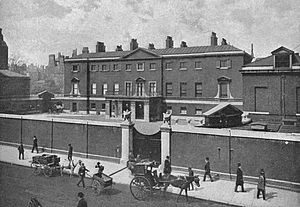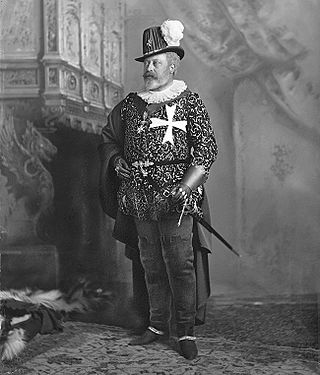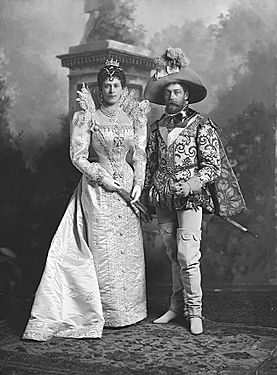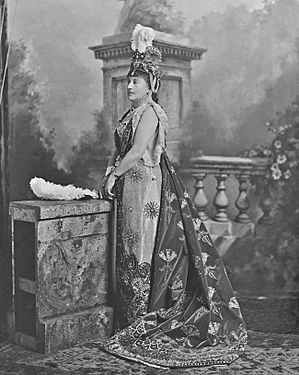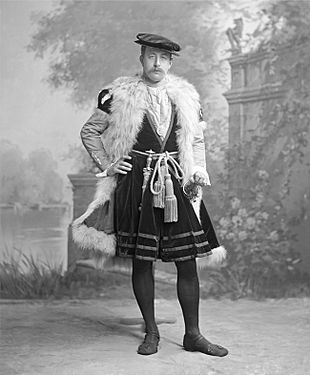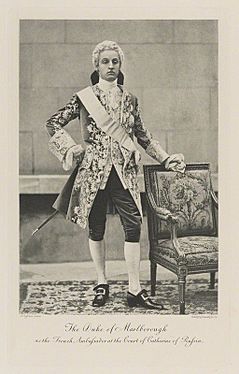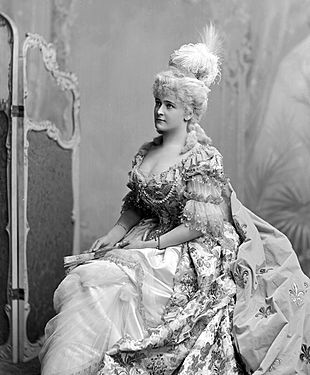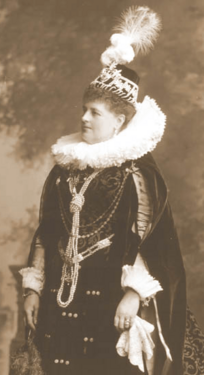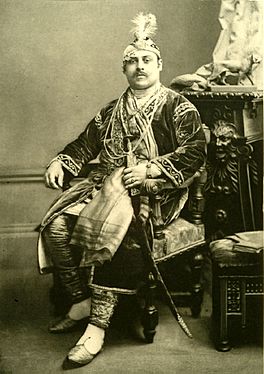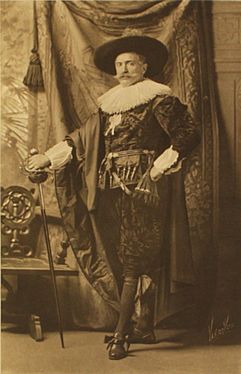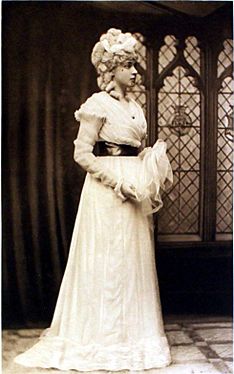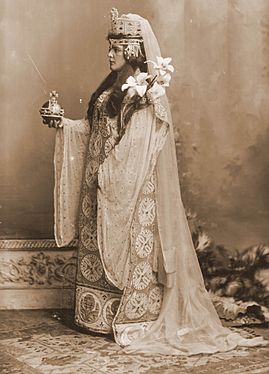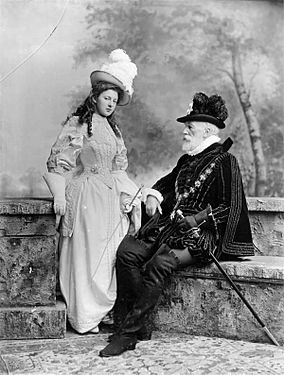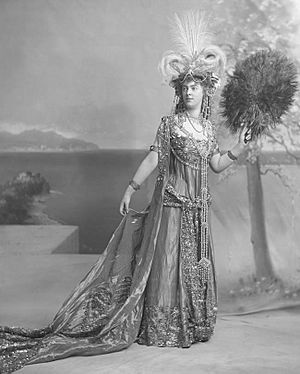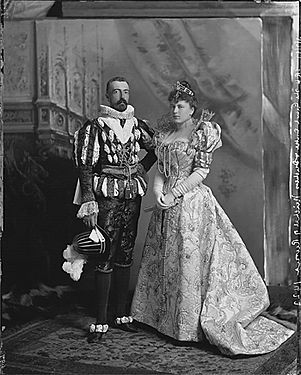Devonshire House Ball of 1897 facts for kids
The Devonshire House Ball was a huge and fancy costume party. It was held on July 2, 1897, at a grand house called Devonshire House in London. The hosts were the Duke and Duchess of Devonshire. This special event celebrated Queen Victoria's Diamond Jubilee, which marked 60 years of her rule. Many important people, including royals and famous figures, attended this very lavish ball. It was considered the most exciting social event of the 1897 London Season, which was a time for many fancy parties and gatherings.
Contents
What Was the Devonshire House Ball?
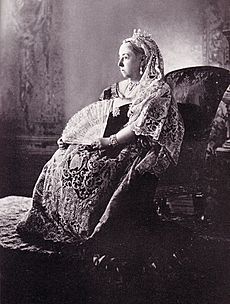
In 1897, the Duke and Duchess of Devonshire decided to host a special costume party. It took place at Devonshire House, their large home in Piccadilly, London. The Duke was an important politician, serving as a Member of Parliament and a government minister. The Duchess was also a well-known figure in society.
After Prince Albert died in 1861, Queen Victoria stopped attending many social events. Her son, the Prince of Wales, and his wife, Alexandra, took over hosting royal parties. They had hosted a successful costume ball in the 1870s, which made these events very popular.
The Devonshires were good friends with the Prince and Princess of Wales. They decided to throw a costume ball to celebrate Queen Victoria's Diamond Jubilee. This jubilee was a huge celebration of the Queen's 60 years on the throne. The main procession for the Jubilee had happened on June 22, 1897, with a six-mile parade through London.
About a month before the ball, over 700 invitations were sent out. Some reports even said up to 3,000 invitations were sent! However, there was a small mistake. Alfred, Duke of Saxe-Coburg and Gotha and his wife, Maria, did not receive an invitation. When the Duchess of Devonshire saw Maria at another party, she asked if she was coming to the ball. Maria replied, "Certainly not," because she hadn't been invited.
Even though the Queen did not attend, almost all of the British royal family were there. Many other royal families from Europe also had representatives at the ball. The Duke of Devonshire hired a famous photography company, James Lafayette, to take pictures of the guests. They set up a special tent in the garden to photograph everyone in their amazing costumes. Later, in 1899, 286 of these photographs were published.
After the ball, the Duchess received a letter from Francis Knollys, the Queen's private secretary. He shared that the Prince of Wales, who arrived after 11 PM, thought the party was a great success.
Who Attended the Ball?
Many important and famous people attended the Devonshire House Ball. They all wore incredible costumes! Here are some of the notable guests:
- The Prince of Wales dressed as the Grand Master of the Knights Hospitallers of Malta. His wife, The Princess of Wales, came as Queen Marguerite de Valois.
- The Duke of York (who later became King George V) dressed as the Earl of Cumberland. The Duchess of York wore a costume of a Lady from Queen Marguerite de Valois's Court.
- Czar Nicholas II of Russia and Czarina of Russia wore old Court clothes from the time of Peter the Great.
- The host, Spencer Cavendish, 8th Duke of Devonshire, dressed as Emperor Charles V. The hostess, the Duchess of Devonshire, was dressed as Zenobia, Queen of Palmyra.
- Lady Randolph Spencer-Churchill, who was the mother of Winston Churchill, wore a Byzantine costume as the Empress Theodora.
- Daisy Greville, Countess of Warwick, came dressed as Marie Antoinette.
- The Duke of Marlborough dressed as a French Ambassador from the time of Catherine the Great.
- Sir Henry Irving, a famous actor, was also a guest.
- John Hay, the U.S. Ambassador to the United Kingdom, represented the United States.
- Prince Victor Duleep Singh, the son of Maharajah Duleep Singh, also attended.
Amazing Costumes
The costumes at the Devonshire House Ball were truly spectacular. Guests spent a lot of money and effort to create their outfits.
The Duchess of Devonshire's costume as Zenobia, Queen of Palmyra, was described in great detail by The Times newspaper. It was incredibly fancy: "The Duchess of Devonshire, as Zenobia, Queen of Palmyra, wore a magnificent costume. The skirt of gold fabric was embroidered all over with a star design. It had emeralds, sapphires, diamonds, and other jewels, all outlined with gold. The front opened to show an underdress of cream silk, decorated with silver, gold, and pearls. It was also covered in diamonds. Her long train was made of beautiful green velvet. It was richly embroidered with designs of lotus flowers in rubies, sapphires, emeralds, and diamonds. The train was lined with turquoise satin. Her top matched the gold skirt and had a front covered in real diamonds, rubies, and emeralds. She wore a gold crown with emeralds, diamonds, and rubies, with pearls hanging down and two tall white ostrich feathers."
One of the most expensive costumes belonged to Charles Spencer-Churchill, 9th Duke of Marlborough. He dressed as the French Ambassador to the Court of Catherine the Great. His velvet costume was made by the famous fashion house House of Worth. It was embroidered with silver, pearls, and diamonds. His waistcoat was made of gold and white damask fabric. This costume cost 5,000 francs, which was a huge amount of money! Even the Duke, who had married the wealthy American heiress Consuelo Vanderbilt in 1895, was reportedly surprised by the cost.
Legacy of the Ball
The Devonshire House Ball was so famous that it was even recreated on the London stage! In September 1897, a play called The White Heather by Cecil Raleigh and Henry Hamilton used the ball as the setting for its final act. The New York Times reported that the play's managers even bought some of the actual costumes worn at the ball to use in the show. This play later inspired a film in 1919, also called The White Heather.
Images for kids
-
The Prince of Wales dressed as the Grand Master of the Knights Hospitallers of Malta
-
The Duke of York as The Earl of Cumberland, and The Duchess of York as a Lady of the Court of Marguerite de Valois
-
Victor Cavendish (later the 9th Duke of Devonshire) as Jean de Dinteville from Hans Holbein's painting, The Ambassadors
-
The Duke of Marlborough as the French Ambassador to the Court of Catherine the Great
-
The Countess of Warwick, dressed as Marie Antoinette.
-
Viscount D'Abernon dressed as the Frans Hals' painting Willem van Heythuysen Posing with a Sword
-
The Countess of Lytton dressed as Lady Melbourne
-
Lady Randolph Spencer-Churchill in byzantine costume as the Empress Theodora
-
Daisy, Princess of Pless as Cleopatra
-
Princess Mary Adelaide of Cambridge as her ancestress, Princess Sophia of Hanover
-
Grand Duke Michael Mikhailovich of Russia and his wife, The Countess of Torby, as King Henry IV of France and Gabrielle d'Estrées
See also
- Duchess of Richmond's ball
- Bradley-Martin Ball


